Related Research Articles
The ADI Bumble Bee is an ultralight gyrocopter marketed by Aircraft Designs Inc (ADI). It was the first of its kind when it flew in 1983 and is still available in plans form for homebuilding.
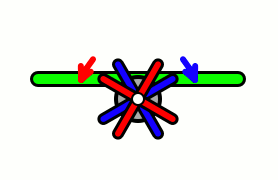
Aircraft equipped with contra-rotating propellers, also referred to as CRP, coaxial contra-rotating propellers, or high-speed propellers, apply the maximum power of usually a single piston or turboprop engine to drive a pair of coaxial propellers in contra-rotation. Two propellers are arranged one behind the other, and power is transferred from the engine via a planetary gear or spur gear transmission. Contra-rotating propellers are also known as counter-rotating propellers, although counter-rotating propellers is much more widely used when referring to airscrews on separate non-coaxial shafts turning in opposite directions.
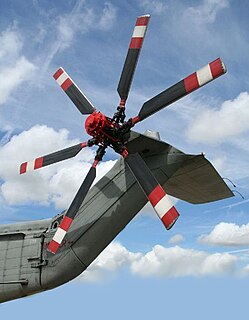
The tail rotor is a smaller rotor mounted vertically or near-vertically at the tail of a traditional single-rotor helicopter, where it rotates to generate a propeller-like horizontal thrust in the same direction as the main rotor's rotation. The tail rotor's position and distance from the helicopter's center of mass allow it to develop enough thrust leverage to counter the reactional torque exerted on the fuselage by the spinning of the main rotor. Without the tail rotor or other anti-torque mechanisms, the helicopter would be constantly spinning in the opposite direction of the main rotor when flying.

A helicopter main rotor or rotor system is the combination of several rotary wings with a control system, that generates the aerodynamic lift force that supports the weight of the helicopter, and the thrust that counteracts aerodynamic drag in forward flight. Each main rotor is mounted on a vertical mast over the top of the helicopter, as opposed to a helicopter tail rotor, which connects through a combination of drive shaft(s) and gearboxes along the tail boom. The blade pitch is typically controlled by the pilot using the helicopter flight controls. Helicopters are one example of rotary-wing aircraft (rotorcraft). The name is derived from the Greek words helix, helik-, meaning spiral; and pteron meaning wing.
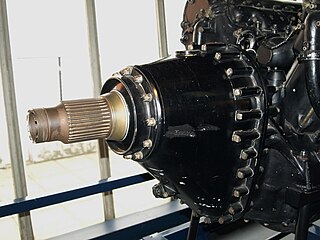
A propeller speed reduction unit is a gearbox or a belt and pulley device used to reduce the output revolutions per minute (rpm) from the higher input rpm of the powerplant. This allows the use of small displacement internal combustion engines to turn aircraft propellers within an efficient speed range.

In aeronautics, a variable-pitch propeller is a type of propeller (airscrew) with blades that can be rotated around their long axis to change the blade pitch. A controllable-pitch propeller is one where the pitch is controlled manually by the pilot. Alternatively, a constant-speed propeller is one where the pilot sets the desired engine speed (RPM), and the blade pitch is controlled automatically without the pilot's intervention so that the rotational speed remains constant. The device which controls the propeller pitch and thus speed is called a propeller governor or constant speed unit.

An aircraft propeller, also called an airscrew, converts rotary motion from an engine or other power source into a swirling slipstream which pushes the propeller forwards or backwards. It comprises a rotating power-driven hub, to which are attached several radial airfoil-section blades such that the whole assembly rotates about a longitudinal axis. The blade pitch may be fixed, manually variable to a few set positions, or of the automatically variable "constant-speed" type.
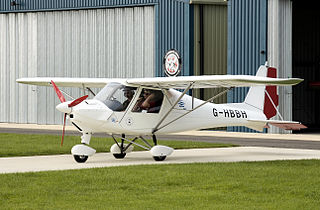
The Ikarus C42 is a two-seat, fixed tricycle gear, general aviation microlight aircraft, manufactured in Germany by Comco Ikarus. It is used primarily for flight training, touring and personal flying.

The Rotax 582 is a 48 kW (64 hp) two-stroke, two-cylinder, rotary intake valve, oil-in-fuel or oil injection pump, liquid-cooled, gear reduction-drive aircraft engine manufactured by BRP-Rotax GmbH & Co. KG. It is for use in non-certified aircraft operating in day visual flight rules.

Ivoprop Corporation, founded in 1984 by Ivo Zdarsky, is an American manufacturer of composite propellers for homebuilt and ultralight aircraft, as well as airboats. The company's headquarters are in Long Beach, California.
The Air Command Commander is an American autogyro that was designed and produced by Air Command International, with its first flight in 1984. Production was completed by 2003. The aircraft was supplied as a kit for amateur construction.
The Apollo Jet Star is a Hungarian ultralight trike, designed and produced by Apollo Ultralight Aircraft of Eger. The aircraft is supplied as a kit for amateur construction or as a complete ready-to-fly-aircraft.
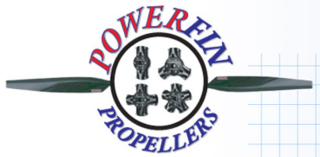
Powerfin Propellers, is an American manufacturer of composite propellers for homebuilt, light-sport and ultralight aircraft, as well as wind power generation systems. The company headquarters is located in Hurricane, Utah, although it was formerly in El Campo, Texas and originated in Arlington, Washington.
The Rotorwing-Aero 3D-RV is an American autogyro that was designed by Monte Hoskins and produced by Rotorwing-Aero of Salt Lake City, Utah, introduced in 1989. Now out of production, when it was available the aircraft was supplied in the form of plans for amateur construction.
The Sun Flightcraft Air-Chopper is an Austrian powered parachute that was designed by Herbert Hofbauer and produced by Sun Flightcraft of Innsbruck. Now out of production, when it was available the aircraft was supplied complete and ready-to-fly.

Sun Flightcraft is a former Austrian aircraft manufacturer based in Innsbruck, founded by Herbert Hofbauer. The company at one time specialized in the design and manufacture of powered parachutes in the form of ready-to-fly aircraft for the European Fédération Aéronautique Internationale microlight category.
The NeuraJet Neura Jet is an Austrian paramotor that was designed by Hans Neudorfer and produced by NeuraJet of Senftenbach for powered paragliding. Now out of production, when it was available the aircraft was supplied complete and ready-to-fly.
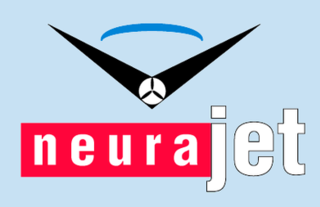
NeuraJet was an Austrian aircraft manufacturer based in Senftenbach and founded by Hans Neudorfer. The company employees were Neudorfer & Annemarie Humer. It specialized in the design and manufacture of paramotors in the form of ready-to-fly aircraft for the US FAR 103 Ultralight Vehicles rules and the European microlight category.
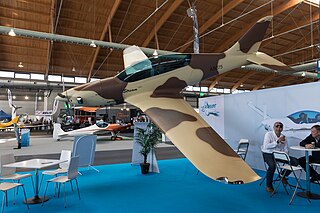
The TL-Ultralight Stream is a Czech ultralight aircraft, designed and produced by TL-Ultralight of Hradec Králové, introduced at the AERO Friedrichshafen show in 2013.

The DTA J-RO (transl. gyro) is a French autogyro designed and produced by DTA sarl of Montélimar. The aircraft is supplied complete and ready-to-fly.
References
- 1 2 3 4 5 "Sunflightcraft Coax-P". sunflightcraft.com. Retrieved 4 November 2015.
- 1 2 3 Bertrand, Noel; Rene Coulon; et al: World Directory of Leisure Aviation 2003-04, page 70. Pagefast Ltd, Lancaster UK, 2003. ISSN 1368-485X
- 1 2 3 "Über Neura Jet - Coaxial". neurajet.at. Archived from the original on 17 December 2005. Retrieved 4 November 2015.